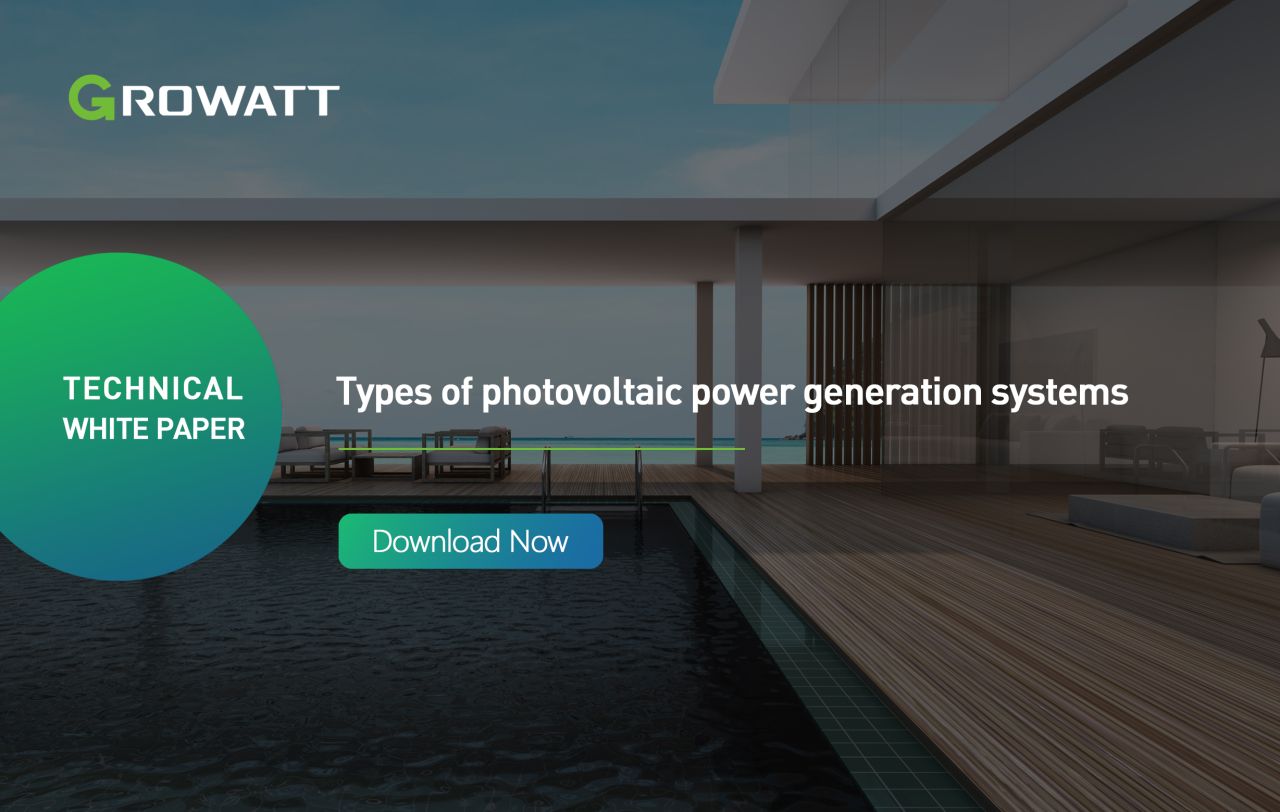Types of photovoltaic power generation systems
2024-03-20

As distributed photovoltaics become increasingly prevalent in thousands of households, the demands for photovoltaic solutions are becoming more diverse. The conventional on- grid system, where photovoltaic power generation is primarily for self-use, is no longer the sole option. Depending on the specific requirements of different scenarios, photovoltaic power generation systems can be categorized into five types: photovoltaic on-grid systems, photovoltaic on-grid energy storage systems, photovoltaic off-grid energy storage systems, photovoltaic on/off-grid energy storage systems, and photovoltaic storage microgrid systems.
1.Photovoltaic on-grid system
Main components: solar modules, on-grid inverter, load and grid.
Working logic: The DC power generated by the solar panel is converted into AC power by the inverter, supplying the power to the loads and feed into the grid.
Application scenarios: large ground power stations, medium-sized industrial andcommercial power stations, small household power stations, etc.
Advantages: There is no need to use batteries, which saves costs; from an investment perspective, excess electricity can be sold to power companies to obtain profits.
2.Photovoltaic on-grid energy storage system
Main components: solar modules, battery, on-grid energy storage inverters, loads and grid.
Working logic: When the solar power is greater than the load power, part of the solar energy is converted into alternating current through the inverter to power the load, and the surplus solar energy will be stored into the battery; when the solar power cannot meet the load needs, the inverter convert the battery's power to supply the load to ensure the continuity and stability of the entire system.
Application scenario: It ’ s often used in the solar self-consumption application that no benefit of the surplus solar energy feeding into the grid or the electricity price is much more expensive than the feed-in tariff, and being used in the application of peak tariff is more expensive than off-peak tariff.
Advantages: The system offers the advantage of storing excess power generated during sunny periods, thereby increasing the proportion of self-consumed energy.
3.Photovoltaic off-grid energy storage system
Main components: solar modules, off-grid inverter, battery, load and grid.
Working logic: It operates independently without relying on the power grid. When there is sunlight, it converts DC power into household AC power, supplies power to the load, and charges the battery pack at the same time; when there is no sunlight, the battery supplies power to the AC load through the inverter.
Application scenarios: It is widely used in remote mountainous areas, areas without power, islands, communication base stations, street lights and other application places. It is mainly used in areas without power grid or areas with frequent power outages.
Advantages: Not subject to geographical restrictions, not dependent on the power grid, widely used, photovoltaic off-grid energy storage systems can be installed and used wherever there is sunlight.
4.Photovoltaic on/off-grid energy storage system
Main components: solar components, off-grid inverter, battery, off-grid load, on-grid load and grid.
Working logic: When sunlight is available, the photovoltaic array converts solar energy into electrical power, supplying energy to the load through the inverter while simultaneously charging the battery pack. During periods of insufficient sunlight, the battery will discharge power to the inverter and subsequently to the AC load. In the event of a power grid failure, the system seamlessly transitions to an off-grid state, providing power to critical loads through backup mode. Upon power grid restoration, the system reverts to on-grid operation.
Application scenarios: It is mainly suitable for applications where the power grid is unstable and has important loads, or where the self-consumption of photovoltaic power cannot be fed into the grid, and the electricity price is much more expensive than the feed-in tariff, and being used in the application of peak tariff is more expensive than off- peak tariff.
Advantages: Batteries can be used to store the electricity generated by photovoltaics to increase the proportion of self-consumption. The batteries can also be charged during off- peak periods and used during peak electricity consumption periods to reduce electricity bills. The most important thing is that when the power grid is outage, it can be converted to off-grid operation, used as backup power supply.
5.Photovoltaic microgrid energy storage system
Main components: solar modules, battery, integrated photovoltaic and storage machines, off-grid loads, on-grid loads and grid.
Working logic: Operable either in parallel with the external power grid or independently, the photovoltaic array converts solar energy into electrical power during sunlight. This power is supplied to the load through the inverter while simultaneously charging the battery through the energy storage inverter. In the absence of sunlight, the battery seamlessly discharge to supply power to the load through the energy storage inverter.
Application scenarios: It is suitable for establishing small and medium-sized distributed power sources in islands and remote mountainous areas where many people live.
Advantages: Encompassing the applications of both off-grid and grid-connected systems, this system offers multiple working modes that maximize the utilization of photovoltaic energy, reducing user dependence on the power grid. It effectively unleashes the potential of distributed clean energy, addressing challenges such as unstable power generation and low reliability of independent power supply. This ensures the safe operation of the power grid. The microgrid system plays a crucial role in promoting the upgrade of traditional industries from economic and environmental perspectives, yielding significant effects.
While each type of photovoltaic power generation system has its own advantages and disadvantages, the key lies in selecting the appropriate system type based on local conditions to match user needs and realize customer value. At present, the photovoltaic grid-connected system is the most important form. It does not use batteries and has low system cost. It is the first choice for investment. However, it is believed that as the cost of energy storage batteries decreases, the application of various photovoltaic energy storage systems will become more and more widespread.
*The article comes from the Internet, if there is any infringement, please contact to delete it.




